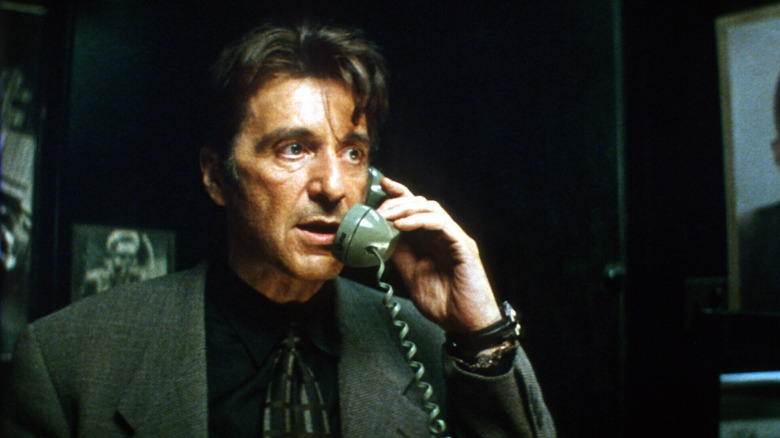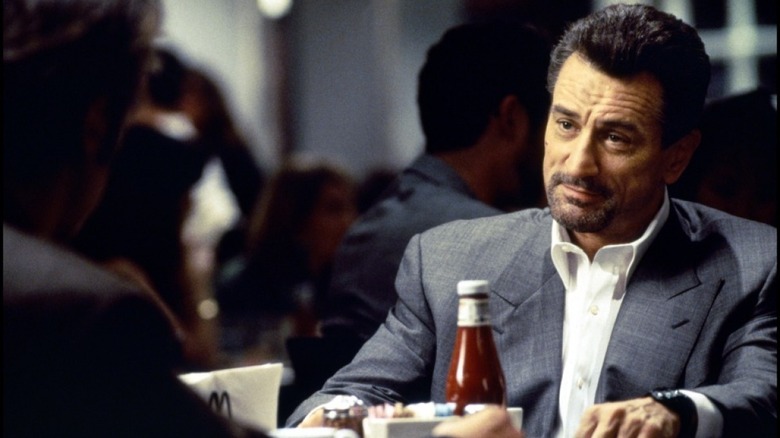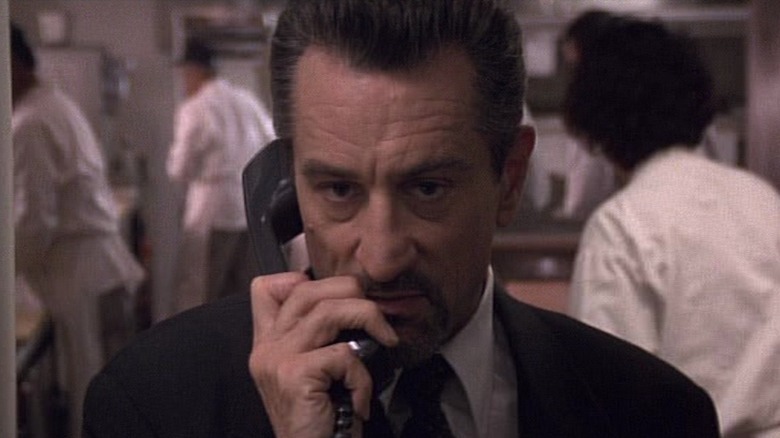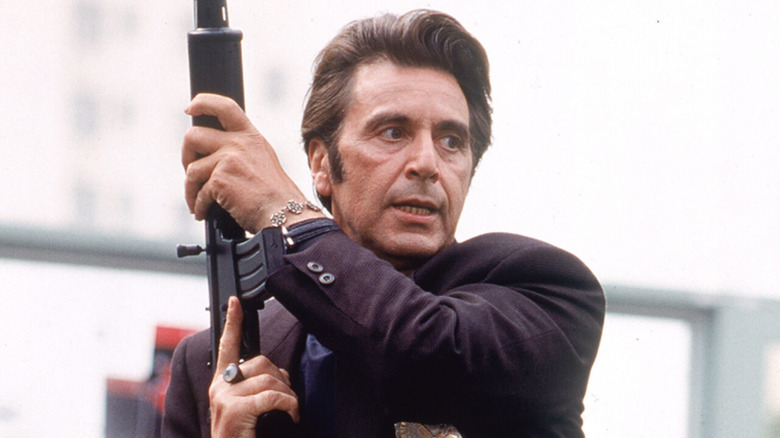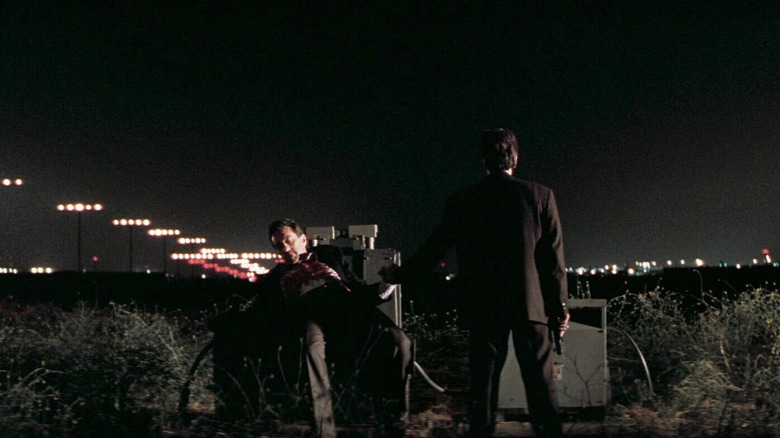Al Pacino And Robert De Niro's Suits Tell A Story In Heat
Michael Mann's 1995 opus "Heat" is a film that dives headfirst into contrasts. It juxtaposes the macro and the micro, following an ensemble of characters on opposite sides of the law who live, work, and converge in the city of Los Angeles. In its broad canvas, it focuses on as many details as possible, with the film circling around two men at the center of its narrative whirlpool: Lieutenant Vincent Hanna (Al Pacino) and professional taker of scores Neil McCauley (Robert De Niro).
Even with two titans of film acting in the central roles, it was a challenge to make the characters distinctive — from each other as well as from the rest of the cast — while still exploring Mann's thesis of Hanna and McCauley being two men cut from the same cloth. Added to that challenge is the fact that the movie was set in the then-present day, with up-to-the-minute fashions needed as opposed to period or fantasy clothes.
Leave it to legendary costume designer Deborah Lynn Scott, who devised the looks for numerous iconic film characters in movies from "Back to the Future" to last month's "Avatar: The Way of Water." Working with Mann, Scott devised a look for Hanna and McCauley that not only helped define their character but played up to each actor's unique strengths.
Clothes make the Mann
As a filmmaker, Michael Mann swears by authenticity — in a recent interview with CBS Sunday Morning, the writer/director explained, "To me, the challenge is to get so deep into the specific regional culture, because the deeper I do that, the more universal it becomes."
Speaking recently to /Film, Deborah Lynn Scott echoed that ethos, especially when it came to putting together costumes for "Heat" and its street-level leading men. As Scott elaborated:
"Well, you know it's a suit world, right? You accept that. It's going to be a suit. Michael Mann really wanted to exemplify the differences, even though they're both wearing shirts and suits, and it's quite like that."
In a way, both Vincent Hanna and Neil McCauley's outfits function as uniforms for their characters, the clothes properly inhabiting the men's respective worlds while revealing some secrets about themselves. "Heat" may involve an element of cat-and-mouse, but Scott's costumes make sure the characters emerge while engaging in the hunt.
'That guy's like, a crisp white shirt, not a wrinkle.'
For Neil McCauley, Michael Mann wanted to emphasize the professional thief's code of anonymity, where McCauley's philosophy of "Don't let yourself get attached to anything you are not willing to walk out on in 30 seconds flat if you feel the heat around the corner" becomes his aesthetic. As costumer Deborah Lynn Scott explained:
"De Niro's character comes out of the prison system, basically. He's so precise. That guy's like, a crisp white shirt, not a wrinkle. We went through maybe 100 gray suits to get to that one. It's like, that was the one, and then we tailored it to make it even more [right]. He was pretty much no frill. He didn't have jewelry. He was sharp and clean."
Robert De Niro followed Scott's lead, portraying McCauley as no-nonsense, low-key, and rigidly determined — even his voice rarely rises above a whisper, the better to not draw too much attention to himself. It's a performance Scott praises De Niro for, observing how "De Niro can be quite still, and was unbelievably focused in 'Heat.' Just an incredible performance."
As the costume helped De Niro's performance, Scott's suave but anonymous look for the McCauley character was clearly appreciated by Mann, too — he resurrected the look in 2004's "Collateral" for the professional assassin Vincent, played by Tom Cruise.
Letting Pacino do 'his Pacino thing'
In contrast to Neil McCauley's sharp, anonymous professionalism, Vincent Hanna is a man who pursues his prey with flash, bravado, and cunning — part intimidation tactic, part distraction to imbalance his targets. That demeanor fits nicely with Al Pacino's undeniably theatrical mannerisms on screen, of which "Heat" is a sterling example. As Deborah Lynn Scott detailed:
"Pacino, he automatically brings more motion to his characters, in a way. [...] Pacino could slump back and do the things, his Pacino thing, and his clothing was dark and moody, and he had, really, a signature ring that we found for him, that he really clung to."
As Scott alludes to, Hanna has a sadness to him that's often masked where McCauley's loneliness is more exposed. His relationship with his third wife, Justine (Diane Venora), is disintegrating bit by bit, leading to a fixation with that ring that Scott mentions.
Opposites attract
Great costuming shouldn't be only defined by period piece accuracy or extravagant design. Good costume design should help tell a story, and Vincent Hanna's ring is a great example of how costuming involves all aspects of a character, from their function to their inner lives. It's also indicative of the way Deborah Lynn Scott cleverly approached "Heat," building distinctive characters out of everyday elements. As she observed:
"...that difference and yet similarity, you take the same items, a shirt, a suit, a pair of pants, and you just go absolutely opposites in terms of character development."
There's a solemn inevitability to "Heat," where characters meet their fates because they can't fight their true natures. It all leads to that elegantly composed and constructed final moment, in which Hanna and McCauley no longer look like black-and-white opposites. Indeed, like Scott's suits for Neil McCauley, they seem more like shades of grey.
